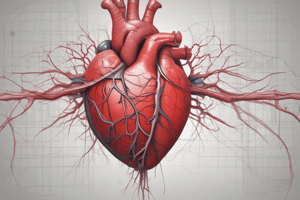Podcast
Questions and Answers
What is the primary function of the pericardium?
What is the primary function of the pericardium?
- It protects the heart from infections.
- It helps in the circulation of blood.
- It acts as a reservoir for blood.
- It allows the heart to beat without friction. (correct)
Which layer of the pericardium adheres directly to the heart's surface?
Which layer of the pericardium adheres directly to the heart's surface?
- Visceral layer (correct)
- Fibrous pericardium
- Pericardial cavity
- Parietal layer
What type of fluid is found in the pericardial cavity, and what is its purpose?
What type of fluid is found in the pericardial cavity, and what is its purpose?
- Lymph fluid; it assists in immune response.
- Serous fluid; it provides nutrients to the heart.
- Pericardial fluid; it reduces friction. (correct)
- Blood; it supplies oxygen to the heart tissue.
What condition refers to the inflammation of the pericardium?
What condition refers to the inflammation of the pericardium?
How is the fibroelastic structure of the pericardium anchored?
How is the fibroelastic structure of the pericardium anchored?
What is the primary structural role of the fibrous pericardium?
What is the primary structural role of the fibrous pericardium?
Which layer of the pericardium is responsible for reducing friction during heartbeats?
Which layer of the pericardium is responsible for reducing friction during heartbeats?
What is the maximum volume of pericardial fluid expected in the pericardial cavity?
What is the maximum volume of pericardial fluid expected in the pericardial cavity?
What condition is characterized by inflammation of the pericardium and may cause a friction rub?
What condition is characterized by inflammation of the pericardium and may cause a friction rub?
How does the pericardium assist in the heart's function during movement?
How does the pericardium assist in the heart's function during movement?
Flashcards are hidden until you start studying
Study Notes
Pericardium Function
- The pericardium is a double-walled sac surrounding the heart.
- It allows the heart to beat smoothly and expands with each heartbeat.
- It prevents overexpansion of the heart.
Pericardium Structure
- The Fibrous Pericardium is the tough outer layer.
- The Serous Pericardium is the inner layer with two parts:
- Parietal Layer lines the fibrous pericardium.
- Visceral Layer is the epicardium and is part of the heart.
- The Pericardial Cavity is the space between the parietal and visceral layers.
- It contains 5 to 30 mL of fluid to reduce friction.
- Inflammation of the pericardium is known as Pericarditis.
- Pericarditis can cause a friction rub, which sounds like a grating sensation.
Pericardium Structure
- The pericardium is a two-layered membrane that encloses the heart, composed of the fibrous pericardium and the serous pericardium.
- The fibrous pericardium is the tough outer layer.
- The serous pericardium has two layers: the parietal layer, which lines the fibrous pericardium, and the visceral layer (epicardium), which is adhered to the heart's surface and is the outermost layer of the heart itself.
- The space between the parietal and visceral layers of the serous pericardium is called the pericardial cavity and is filled with pericardial fluid.
- The pericardial fluid provides lubrication, reducing friction during heart contractions.
- Inflammation of the pericardium is called pericarditis. Pericarditis can produce a friction rub, an audible sound caused by the inflamed pericardium rubbing against the heart.
Studying That Suits You
Use AI to generate personalized quizzes and flashcards to suit your learning preferences.




